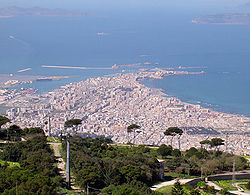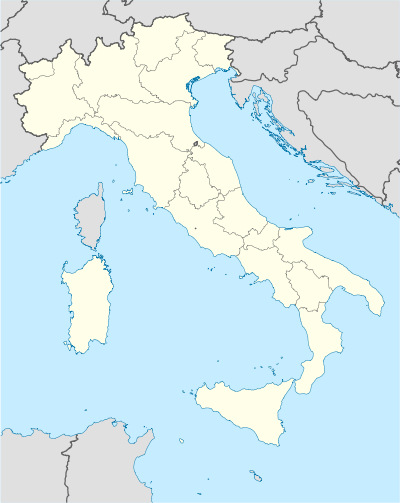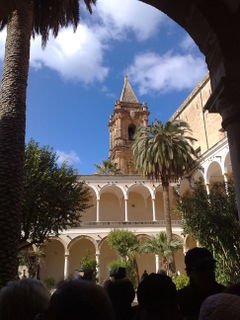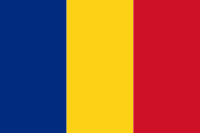Trapani
| Trapani | |
|---|---|
| — Comune — | |
| Città di Trapani | |
 |
|
 Trapani
|
|
| Coordinates: | |
| Country | Italy |
| Region | Sicily |
| Province | Trapani (TP) |
| Frazioni | Marausa, Xitta, Palma, Fontanasalsa, Guarrato, Fulgatore, Salinagrande, Locogrande, Rilievo, Borgo Fazio, Ummari |
| Government | |
| - Mayor | Girolamo Fazio |
| Area | |
| - Total | 271 km2 (104.6 sq mi) |
| Elevation | 3 m (10 ft) |
| Population (1 January 2008) | |
| - Total | 70,638 |
| - Density | 260.7/km2 (675.1/sq mi) |
| Demonym | Trapanesi |
| Time zone | CET (UTC+1) |
| - Summer (DST) | CEST (UTC+2) |
| Postal code | 91100 |
| Dialing code | 0923 |
| Patron saint | St. Albert |
| Saint day | August 7 |
| Website | Official website |

- Drepanon redirects here; it may also refer to Drepanon in Bithynia, later named Helenopolis.
Trapani listen (Sicilian: Tràpani) is a city and comune on the west coast of Sicily in Italy. It is the capital of the Province of Trapani. Founded by Elymians, the city is still an important fishing port and the main gateway to the nearby Egadi Islands.
Contents |
History
Trapani was founded by the Elymians to serve as the port of the nearby city of Erice (ancient Eryx), which overlooks it from Monte San Giuliano. The city sits on a low-lying promontory jutting out into the Mediterranean Sea. It was originally named Drépanon from the Greek word for "sickle", because of the curving shape of its harbour. Carthage seized control of the city in 260 BC, subsequently making it an important naval base, but ceded it to Rome in 241 BC following the Battle of the Aegates in the First Punic War.
Two ancient legends tell of mythical origins for the city. In the first legend, Trapani stemmed from the sickle which fell from the hands of the goddess Demeter while she was seeking for her daughter Persephone, who had been kidnapped by Hades. The second myth features Saturn, god of the sky, who eviscerated his father Cronus with a sickle which, falling into the sea, created the city. In ancient times Saturn was the god-protector of Trapani. Today Saturn's statue stands in a piazza in the centre of the city.
After the Roman, Vandal, Byzantine and (from the 9th century) Arab dominations, Trapani was conquered by the Normans of Roger I, flourishing under their dominations and having also a role in the Crusades as one of the most important ports in the Mediterranean Sea. In the 17th century the city decayed due to revolts, plagues and famines; however in the following century it grew from 16,000 to 30,000 inhabitants; commerce remained of local importance, while its military position in the Kingdom of Naples remained notable.
The city was badly damaged during World War II when it was subjected to intense Allied bombardments. It has grown greatly since the end of the war, sprawling out virtually to the foot of Monte San Giuliano. Tourism has grown in recent years due to the city's proximity to popular destinations such as Erice, Segesta and the Egadi Islands.
Economy
Much of Trapani's economy still depends on the sea. Fishing and canning are the main local industries, with fishermen using the mattanza technique to catch tuna. Coral is also an important export, along with salt, marble and marsala wine. The nearby coast is lined with numerous salt-pans.
The city is also an important ferry port, with links to the Egadi Islands, Pantelleria, Sardinia and Tunisia. It also has its own airport, the Trapani-Birgi Airport.
Main sights
Much of the old city of Trapani dates from the later medieval or early modern periods; there are no extant remains of the ancient city. Many of the city's historic buildings are designed in the Baroque style. Notable monuments include:
- The Church of Sant'Agostino (14th century, with the splendid rose-window
- The Church of Santa Maria di Gesù (15th century-16th century)
- The magnificent Basilica-Sanctuary of Maria Santissima Annunziata (also called "Madonna di Trapani") originally built in 1315–1332 and rebuilt in 1760. It houses a marble statue of the Madonna of Trapani, which might be the work of Nino Pisano, and with the museum Agostino Pepoli.
- Fontana di Tritone ("Triton's Fountain")
- The Baroque Palazzo della Giudecca or Casa Ciambra.
- The Cathedral (built in 1421, but restored to the current appearance in the 18th century by Giovanni Biagio Amico). It includes an Annunciation attributed to Anthony van Dyck.
- Church of Maria SS. dell'Intria, another notable example of Sicilian Baroque.
- Church of Badia Nuova, a small Baroque church.
The city is renowned for its Easter procession, The Misteri, when the city's guilds carry groups of sculpted 17th century and 18th century religious statues through the streets in a procession lasting for 16 hours on Good Friday and Holy Saturday. Additional information and pictures of this event are available on [1].
Monte Erice is a cable car ride from the city and aside from the cobbled streets and medieval castle, there are views of Tunisia and Africa from up there on clear days.
There are several beaches running along the coast of Trapani, the best of which are at Marausa about 9km south of the city.
Sport
From 28 September to 9 October, 2005 Trapani was the location of Acts 8 and 9 of the Louis Vuitton Cup. This sailing race featured, among other entrants, all the boats that took part in the 2007 America's Cup.
Twin towns — sister cities
Trapani is twinned with:
 Constanţa, Romania
Constanţa, Romania Les Sables-d'Olonne, France
Les Sables-d'Olonne, France
External links
|
|||||